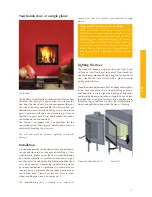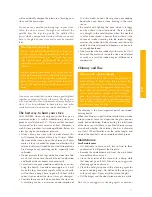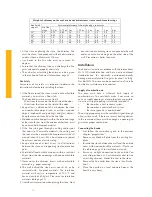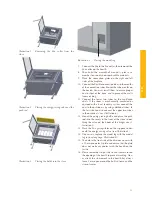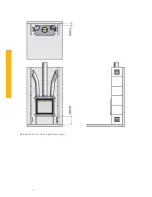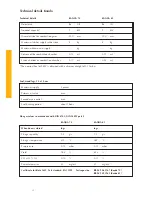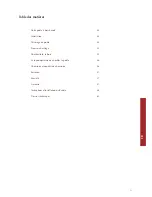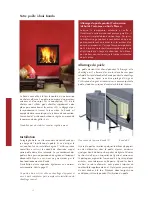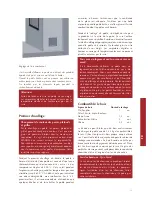
21
GB
will considerably dampen the pleasure of burning your
stove and the heat output.
Do not put any paraffin-containing logs in your stove.
When the door is closed, the high heat will melt the
paraffin from the logs too quickly. The polluted flue
gasses which consequently develop will deposit on and
burn in the glass of your stove and cannot be removed
later.
Do not use any wood that is painted, impregnated, glued
together or processed in any other way. The flue gases
are very harmful to the environment and may affect your
stove. It is also prohibited to burn plastics and other
waste matter due to poisonous smoke development.
The best way to burn your stove
All WANDERS’ stoves are designed so that they give a
maximum output. A well-lit wood-burning stove can
produce a yield of about 75%. This means that you need
less wood for the same amount of heat. Moreover, a
well-lit stove produces less smoke pollution. Below are
a few tips to give you optimum pleasure:
• Always burn your stove with its door closed; this
will improve the output within 8 to 10 times. When
the door of the stove is open, the chimney will draw
more air than is needed for proper combustion. The
relatively cold air will cool the fire. It will also preclude
fire damage by any sputtering sparks, especially from
softwood.
• Do not put more than 3 logs on the fire at one time. Too
much fuel at one time thwarts efficient combustion
and burdens the environment unnecessarily.
• Let extra air into your wood stove only when you start
firing the hearth. A constant oversupply of air will
make the logs burn more rapidly while your hearth
will not have enough time to give off its heat to the
room; if you overheat the stove, it may get damaged.
• Ventilate the space well when you have the stove on.
A crackling fire has a minimum air consumption of
25 cubic metres an hour. Never put on your cooking
hood when you have a stove burning in the same
space.
• Be careful with lighting the stove when it is foggy
or when there is no wind outside. There is hardly
any draught in the cold chimney when the weather
is calm. Since smoke is heavier than air there is the
chance of smoke streaming into the room. In foggy
weather, the smoke from the chimney (outside) cools
quickly and may descend and become a nuisance in
your neighbourhood.
• Don’t smother the fire suddenly with water, but let it
burn out. The materials inside the stove may deform
or crack as a result of sudden or great differences in
temperature.
Chimney and flue
The chimney is the most important part of your wood-
burning hearth.
When the chimney is right it will not distribute any smoke
into your room, leave any deposit on the glass pane or
create bad combustion. Before starting the installation
of the stove, your installer or a qualified chimney sweep
must check whether the chimney flue has a diameter
of at least 150 millimetres over the entire length, and
whether the channel is clean, smooth and leak-proof.
Maintenance
Small maintenance
• It is advisable to leave an ash layer of two to three
centimetres. It will protect the fire plate.
• Remove the cooled-down ash from the ash bucked
two or three times a week.
• Clean the exterior of the stove with a damp cloth
that does not give off fluff. Do not use any aggressive
cleansing agents or abrasives.
• Clean the cold glass pane with a cleaning agent for
ceramic cooking rings. Do not touch the clean glass
with your fingers. Finger marks burn into the glass.
• Oil the hinges and the door fastener once in a while.
Do not use any aggressive cleaning agents or abrasives
Wood species and storage
You can use all kinds of woods as fuel as long as it
is clean, split and dry. Hardwood like oak, beech
and birch burn slowly, give off much heat and
form charcoal easily. Softer woods like spruce, fir
and poplar give more flames but less heat and less
charcoal.
The best place to store timber is in a windy spot but
sheltered from the rain. This is how the logs can dry
in a natural way. Pile the logs on an old pallet or a
frame to let the wood dry from underneath and to
prevent the lower logs from being in contact with
water.
Chimney with a proper draught
Warm air wants to ascend. This is the principle of
every chimney. It helps when the wind near the
chimney mouth draws the air from the chimney.
Fall wind may give the opposite effect and blow
the air back into the chimney. Relatively cold foggy
air may thwart proper draught in your chimney as
does a long flue pipe with a rough inside and many
bends. If the natural draught in your chimney is poor
your installer can give you information about using
a ventilator for your flue tube.
Summary of Contents for KANDA 100
Page 15: ...15 NL...
Page 16: ...16 User s Guide and Installation Manual Kanda GB...
Page 26: ...26 Illustration 5 Survey of the inbuilt Kanda mm...
Page 31: ...31 FR Mode d emploi et instructions d installation Kanda FR...
Page 42: ...42 Figure 5 Aper u encastrement Kanda mm...
Page 45: ...45 FR...
Page 46: ...46 Gebrauchsanweisung und Installationsvor schriften Kanda Holzofen DE...
Page 62: ...62...
Page 65: ...Technische tekeningen Technical drawings Dessins techniques Technische Zeichnungen 65...
Page 66: ...66...
Page 67: ......
Page 68: ......













